Report on Managing Financial Performance: GSK and Pfizer Analysis
VerifiedAdded on 2020/10/22
|18
|4889
|58
Report
AI Summary
This report provides a detailed analysis of the financial performance of GlaxoSmithKline (GSK) Plc, comparing it with Pfizer Inc. The report begins with an overview of GSK and its business operations, followed by an evaluation of key financial ratios such as Return on Capital Employed, Operating Profit Margin, and Earnings per Share, to assess the company's profitability and efficiency. The analysis includes a comparison of GSK's performance with Pfizer's, highlighting factors influencing their financial outcomes. Furthermore, the report discusses the advantages and drawbacks of zero-based budgeting techniques and evaluates the strengths and weaknesses of the Balanced Scorecard for performance measurement. Finally, it identifies key financial issues that must be considered before making financial decisions, providing a comprehensive overview of financial management and performance analysis within the pharmaceutical industry.

Managing Financial
Performance
Performance
Paraphrase This Document
Need a fresh take? Get an instant paraphrase of this document with our AI Paraphraser
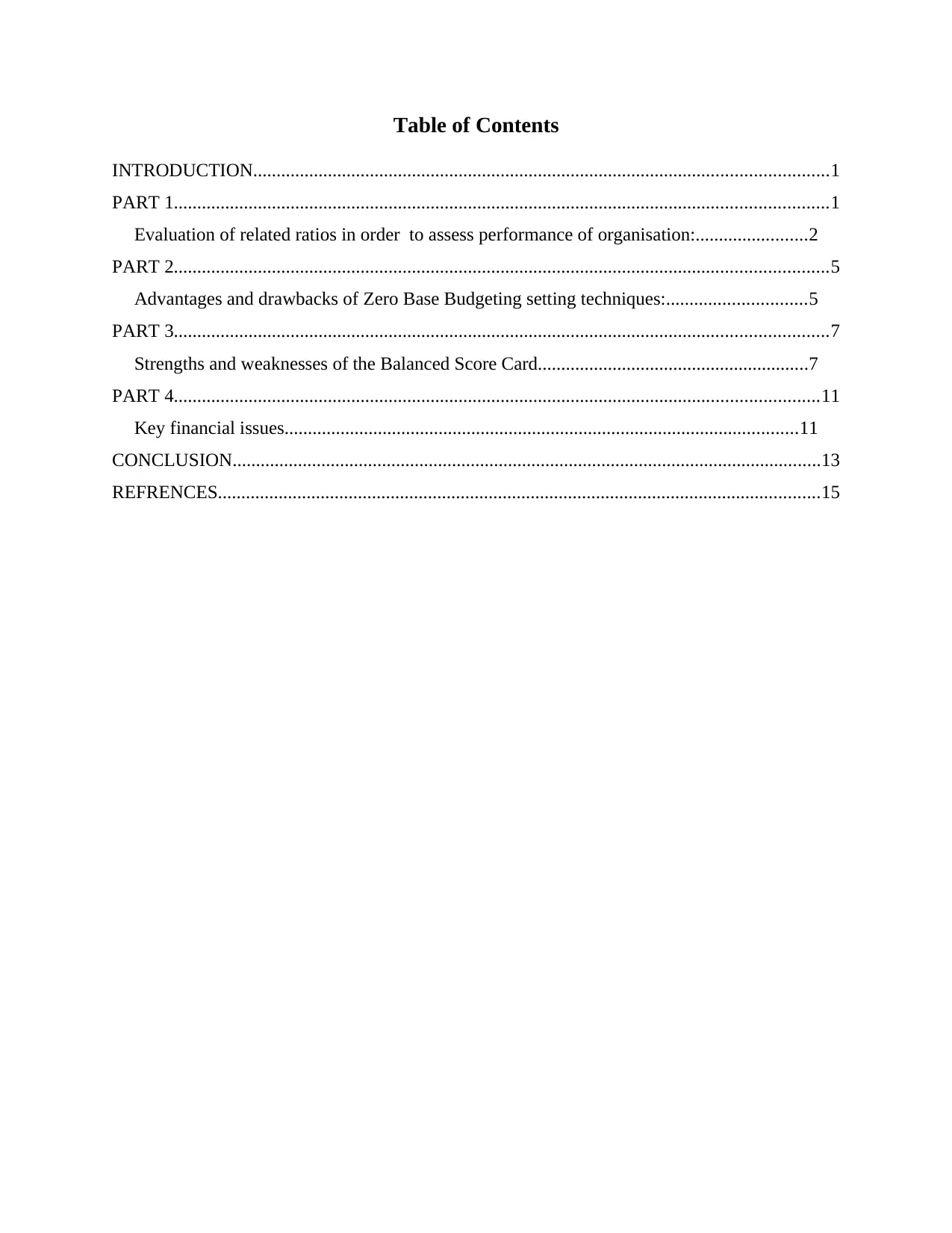
Table of Contents
INTRODUCTION...........................................................................................................................1
PART 1............................................................................................................................................1
Evaluation of related ratios in order to assess performance of organisation:........................2
PART 2............................................................................................................................................5
Advantages and drawbacks of Zero Base Budgeting setting techniques:..............................5
PART 3............................................................................................................................................7
Strengths and weaknesses of the Balanced Score Card..........................................................7
PART 4..........................................................................................................................................11
Key financial issues..............................................................................................................11
CONCLUSION..............................................................................................................................13
REFRENCES.................................................................................................................................15
INTRODUCTION...........................................................................................................................1
PART 1............................................................................................................................................1
Evaluation of related ratios in order to assess performance of organisation:........................2
PART 2............................................................................................................................................5
Advantages and drawbacks of Zero Base Budgeting setting techniques:..............................5
PART 3............................................................................................................................................7
Strengths and weaknesses of the Balanced Score Card..........................................................7
PART 4..........................................................................................................................................11
Key financial issues..............................................................................................................11
CONCLUSION..............................................................................................................................13
REFRENCES.................................................................................................................................15
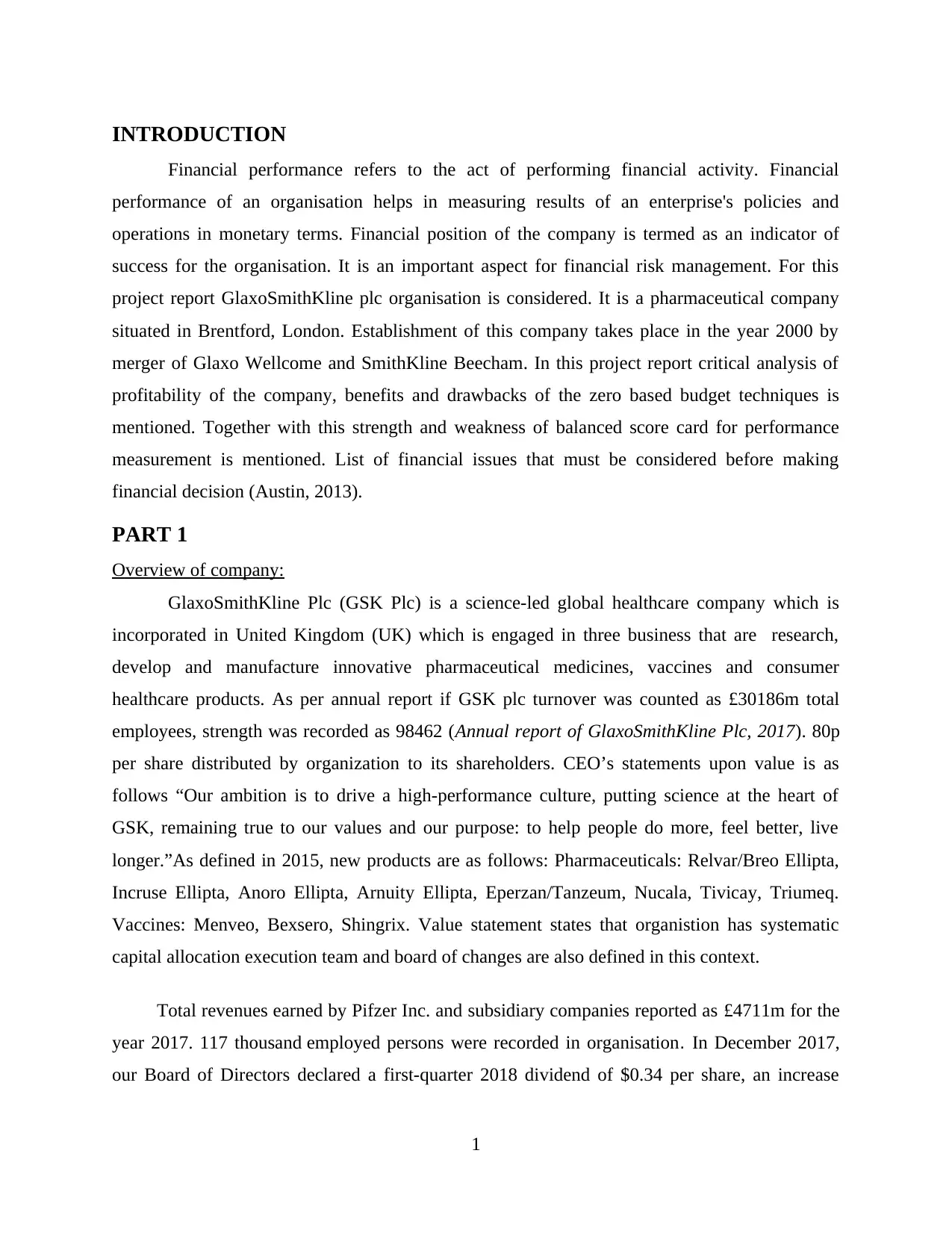
INTRODUCTION
Financial performance refers to the act of performing financial activity. Financial
performance of an organisation helps in measuring results of an enterprise's policies and
operations in monetary terms. Financial position of the company is termed as an indicator of
success for the organisation. It is an important aspect for financial risk management. For this
project report GlaxoSmithKline plc organisation is considered. It is a pharmaceutical company
situated in Brentford, London. Establishment of this company takes place in the year 2000 by
merger of Glaxo Wellcome and SmithKline Beecham. In this project report critical analysis of
profitability of the company, benefits and drawbacks of the zero based budget techniques is
mentioned. Together with this strength and weakness of balanced score card for performance
measurement is mentioned. List of financial issues that must be considered before making
financial decision (Austin, 2013).
PART 1
Overview of company:
GlaxoSmithKline Plc (GSK Plc) is a science-led global healthcare company which is
incorporated in United Kingdom (UK) which is engaged in three business that are research,
develop and manufacture innovative pharmaceutical medicines, vaccines and consumer
healthcare products. As per annual report if GSK plc turnover was counted as £30186m total
employees, strength was recorded as 98462 (Annual report of GlaxoSmithKline Plc, 2017). 80p
per share distributed by organization to its shareholders. CEO’s statements upon value is as
follows “Our ambition is to drive a high-performance culture, putting science at the heart of
GSK, remaining true to our values and our purpose: to help people do more, feel better, live
longer.”As defined in 2015, new products are as follows: Pharmaceuticals: Relvar/Breo Ellipta,
Incruse Ellipta, Anoro Ellipta, Arnuity Ellipta, Eperzan/Tanzeum, Nucala, Tivicay, Triumeq.
Vaccines: Menveo, Bexsero, Shingrix. Value statement states that organistion has systematic
capital allocation execution team and board of changes are also defined in this context.
Total revenues earned by Pifzer Inc. and subsidiary companies reported as £4711m for the
year 2017. 117 thousand employed persons were recorded in organisation. In December 2017,
our Board of Directors declared a first-quarter 2018 dividend of $0.34 per share, an increase
1
Financial performance refers to the act of performing financial activity. Financial
performance of an organisation helps in measuring results of an enterprise's policies and
operations in monetary terms. Financial position of the company is termed as an indicator of
success for the organisation. It is an important aspect for financial risk management. For this
project report GlaxoSmithKline plc organisation is considered. It is a pharmaceutical company
situated in Brentford, London. Establishment of this company takes place in the year 2000 by
merger of Glaxo Wellcome and SmithKline Beecham. In this project report critical analysis of
profitability of the company, benefits and drawbacks of the zero based budget techniques is
mentioned. Together with this strength and weakness of balanced score card for performance
measurement is mentioned. List of financial issues that must be considered before making
financial decision (Austin, 2013).
PART 1
Overview of company:
GlaxoSmithKline Plc (GSK Plc) is a science-led global healthcare company which is
incorporated in United Kingdom (UK) which is engaged in three business that are research,
develop and manufacture innovative pharmaceutical medicines, vaccines and consumer
healthcare products. As per annual report if GSK plc turnover was counted as £30186m total
employees, strength was recorded as 98462 (Annual report of GlaxoSmithKline Plc, 2017). 80p
per share distributed by organization to its shareholders. CEO’s statements upon value is as
follows “Our ambition is to drive a high-performance culture, putting science at the heart of
GSK, remaining true to our values and our purpose: to help people do more, feel better, live
longer.”As defined in 2015, new products are as follows: Pharmaceuticals: Relvar/Breo Ellipta,
Incruse Ellipta, Anoro Ellipta, Arnuity Ellipta, Eperzan/Tanzeum, Nucala, Tivicay, Triumeq.
Vaccines: Menveo, Bexsero, Shingrix. Value statement states that organistion has systematic
capital allocation execution team and board of changes are also defined in this context.
Total revenues earned by Pifzer Inc. and subsidiary companies reported as £4711m for the
year 2017. 117 thousand employed persons were recorded in organisation. In December 2017,
our Board of Directors declared a first-quarter 2018 dividend of $0.34 per share, an increase
1
⊘ This is a preview!⊘
Do you want full access?
Subscribe today to unlock all pages.

Trusted by 1+ million students worldwide
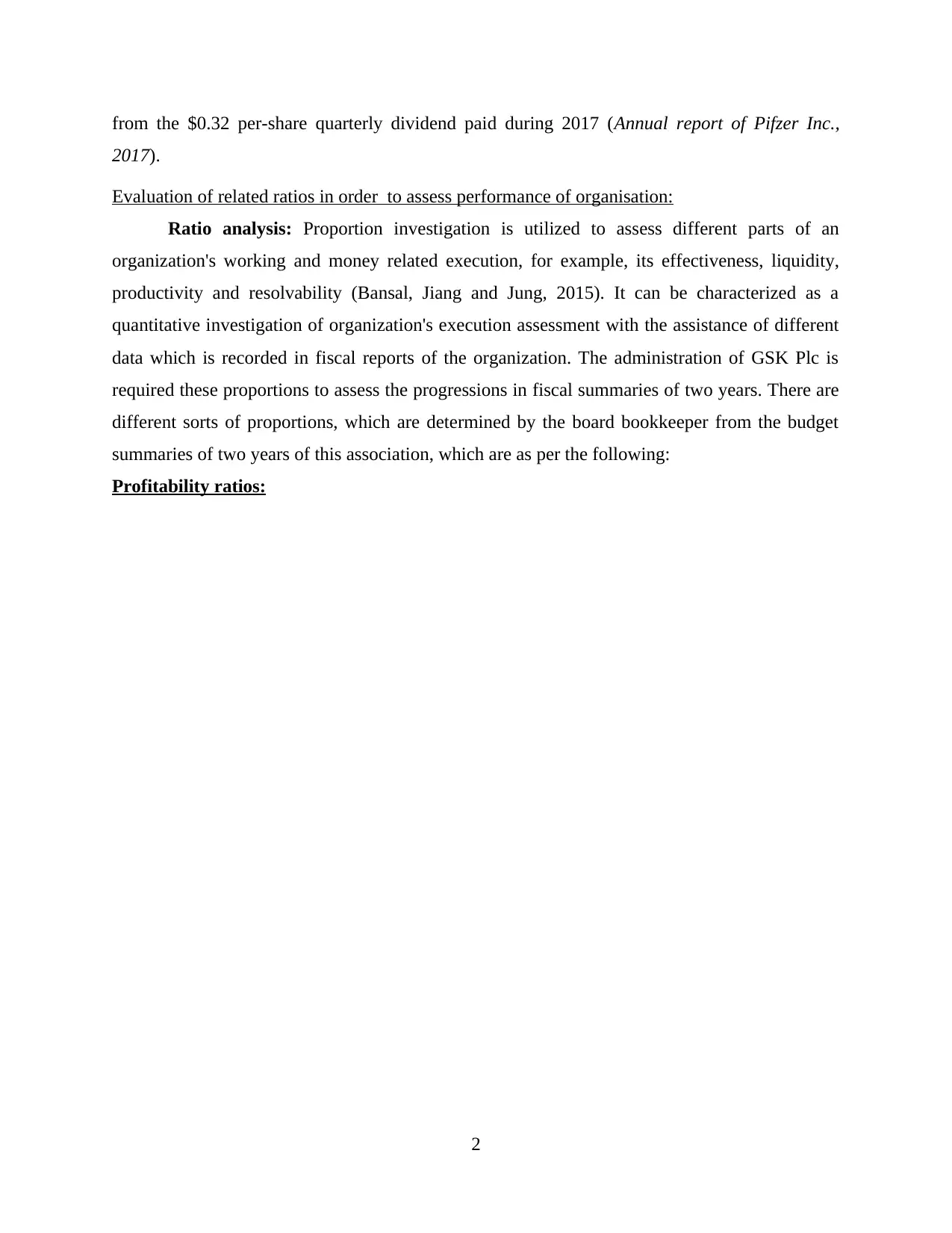
from the $0.32 per-share quarterly dividend paid during 2017 (Annual report of Pifzer Inc.,
2017).
Evaluation of related ratios in order to assess performance of organisation:
Ratio analysis: Proportion investigation is utilized to assess different parts of an
organization's working and money related execution, for example, its effectiveness, liquidity,
productivity and resolvability (Bansal, Jiang and Jung, 2015). It can be characterized as a
quantitative investigation of organization's execution assessment with the assistance of different
data which is recorded in fiscal reports of the organization. The administration of GSK Plc is
required these proportions to assess the progressions in fiscal summaries of two years. There are
different sorts of proportions, which are determined by the board bookkeeper from the budget
summaries of two years of this association, which are as per the following:
Profitability ratios:
2
2017).
Evaluation of related ratios in order to assess performance of organisation:
Ratio analysis: Proportion investigation is utilized to assess different parts of an
organization's working and money related execution, for example, its effectiveness, liquidity,
productivity and resolvability (Bansal, Jiang and Jung, 2015). It can be characterized as a
quantitative investigation of organization's execution assessment with the assistance of different
data which is recorded in fiscal reports of the organization. The administration of GSK Plc is
required these proportions to assess the progressions in fiscal summaries of two years. There are
different sorts of proportions, which are determined by the board bookkeeper from the budget
summaries of two years of this association, which are as per the following:
Profitability ratios:
2
Paraphrase This Document
Need a fresh take? Get an instant paraphrase of this document with our AI Paraphraser
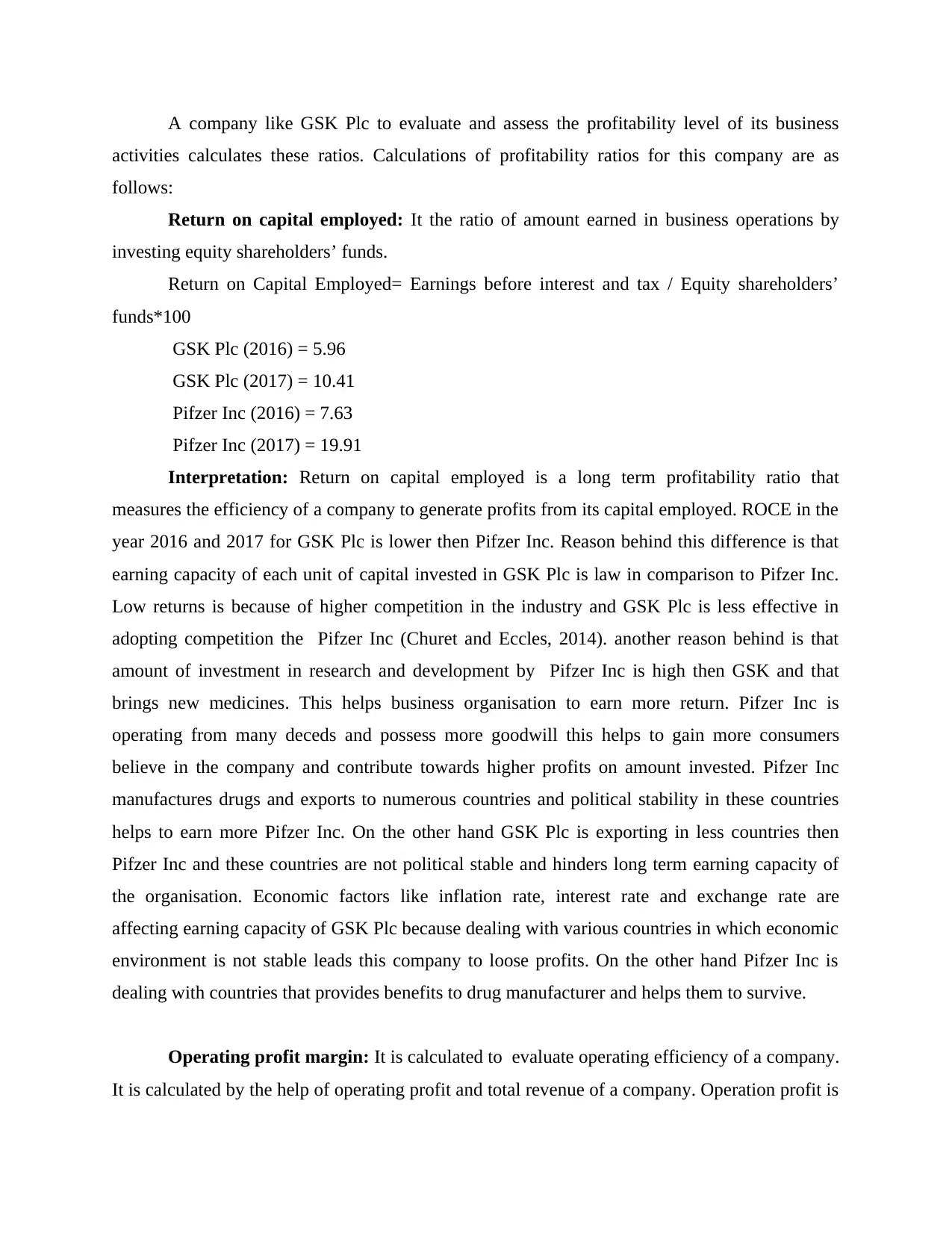
A company like GSK Plc to evaluate and assess the profitability level of its business
activities calculates these ratios. Calculations of profitability ratios for this company are as
follows:
Return on capital employed: It the ratio of amount earned in business operations by
investing equity shareholders’ funds.
Return on Capital Employed= Earnings before interest and tax / Equity shareholders’
funds*100
GSK Plc (2016) = 5.96
GSK Plc (2017) = 10.41
Pifzer Inc (2016) = 7.63
Pifzer Inc (2017) = 19.91
Interpretation: Return on capital employed is a long term profitability ratio that
measures the efficiency of a company to generate profits from its capital employed. ROCE in the
year 2016 and 2017 for GSK Plc is lower then Pifzer Inc. Reason behind this difference is that
earning capacity of each unit of capital invested in GSK Plc is law in comparison to Pifzer Inc.
Low returns is because of higher competition in the industry and GSK Plc is less effective in
adopting competition the Pifzer Inc (Churet and Eccles, 2014). another reason behind is that
amount of investment in research and development by Pifzer Inc is high then GSK and that
brings new medicines. This helps business organisation to earn more return. Pifzer Inc is
operating from many deceds and possess more goodwill this helps to gain more consumers
believe in the company and contribute towards higher profits on amount invested. Pifzer Inc
manufactures drugs and exports to numerous countries and political stability in these countries
helps to earn more Pifzer Inc. On the other hand GSK Plc is exporting in less countries then
Pifzer Inc and these countries are not political stable and hinders long term earning capacity of
the organisation. Economic factors like inflation rate, interest rate and exchange rate are
affecting earning capacity of GSK Plc because dealing with various countries in which economic
environment is not stable leads this company to loose profits. On the other hand Pifzer Inc is
dealing with countries that provides benefits to drug manufacturer and helps them to survive.
Operating profit margin: It is calculated to evaluate operating efficiency of a company.
It is calculated by the help of operating profit and total revenue of a company. Operation profit is
activities calculates these ratios. Calculations of profitability ratios for this company are as
follows:
Return on capital employed: It the ratio of amount earned in business operations by
investing equity shareholders’ funds.
Return on Capital Employed= Earnings before interest and tax / Equity shareholders’
funds*100
GSK Plc (2016) = 5.96
GSK Plc (2017) = 10.41
Pifzer Inc (2016) = 7.63
Pifzer Inc (2017) = 19.91
Interpretation: Return on capital employed is a long term profitability ratio that
measures the efficiency of a company to generate profits from its capital employed. ROCE in the
year 2016 and 2017 for GSK Plc is lower then Pifzer Inc. Reason behind this difference is that
earning capacity of each unit of capital invested in GSK Plc is law in comparison to Pifzer Inc.
Low returns is because of higher competition in the industry and GSK Plc is less effective in
adopting competition the Pifzer Inc (Churet and Eccles, 2014). another reason behind is that
amount of investment in research and development by Pifzer Inc is high then GSK and that
brings new medicines. This helps business organisation to earn more return. Pifzer Inc is
operating from many deceds and possess more goodwill this helps to gain more consumers
believe in the company and contribute towards higher profits on amount invested. Pifzer Inc
manufactures drugs and exports to numerous countries and political stability in these countries
helps to earn more Pifzer Inc. On the other hand GSK Plc is exporting in less countries then
Pifzer Inc and these countries are not political stable and hinders long term earning capacity of
the organisation. Economic factors like inflation rate, interest rate and exchange rate are
affecting earning capacity of GSK Plc because dealing with various countries in which economic
environment is not stable leads this company to loose profits. On the other hand Pifzer Inc is
dealing with countries that provides benefits to drug manufacturer and helps them to survive.
Operating profit margin: It is calculated to evaluate operating efficiency of a company.
It is calculated by the help of operating profit and total revenue of a company. Operation profit is
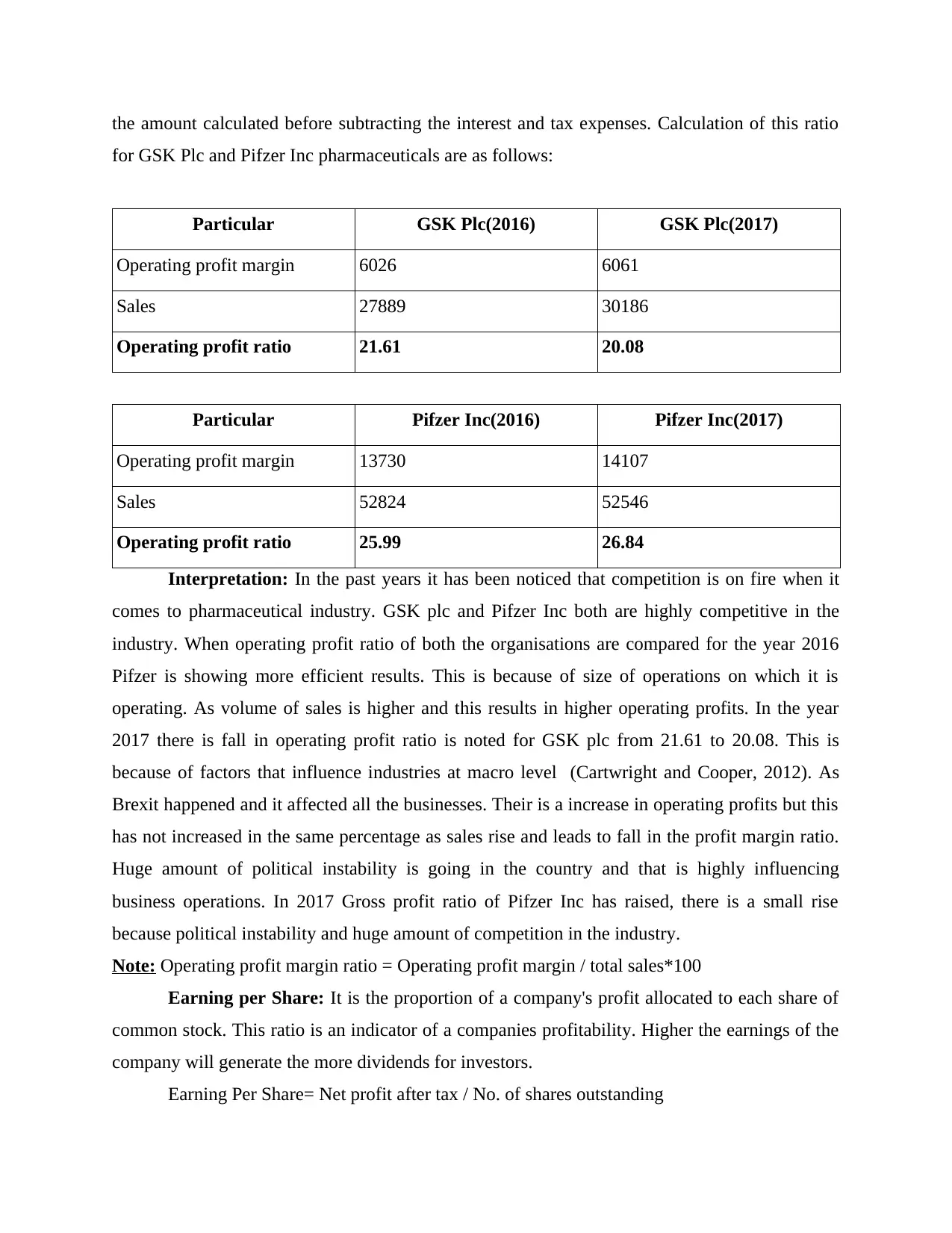
the amount calculated before subtracting the interest and tax expenses. Calculation of this ratio
for GSK Plc and Pifzer Inc pharmaceuticals are as follows:
Particular GSK Plc(2016) GSK Plc(2017)
Operating profit margin 6026 6061
Sales 27889 30186
Operating profit ratio 21.61 20.08
Particular Pifzer Inc(2016) Pifzer Inc(2017)
Operating profit margin 13730 14107
Sales 52824 52546
Operating profit ratio 25.99 26.84
Interpretation: In the past years it has been noticed that competition is on fire when it
comes to pharmaceutical industry. GSK plc and Pifzer Inc both are highly competitive in the
industry. When operating profit ratio of both the organisations are compared for the year 2016
Pifzer is showing more efficient results. This is because of size of operations on which it is
operating. As volume of sales is higher and this results in higher operating profits. In the year
2017 there is fall in operating profit ratio is noted for GSK plc from 21.61 to 20.08. This is
because of factors that influence industries at macro level (Cartwright and Cooper, 2012). As
Brexit happened and it affected all the businesses. Their is a increase in operating profits but this
has not increased in the same percentage as sales rise and leads to fall in the profit margin ratio.
Huge amount of political instability is going in the country and that is highly influencing
business operations. In 2017 Gross profit ratio of Pifzer Inc has raised, there is a small rise
because political instability and huge amount of competition in the industry.
Note: Operating profit margin ratio = Operating profit margin / total sales*100
Earning per Share: It is the proportion of a company's profit allocated to each share of
common stock. This ratio is an indicator of a companies profitability. Higher the earnings of the
company will generate the more dividends for investors.
Earning Per Share= Net profit after tax / No. of shares outstanding
for GSK Plc and Pifzer Inc pharmaceuticals are as follows:
Particular GSK Plc(2016) GSK Plc(2017)
Operating profit margin 6026 6061
Sales 27889 30186
Operating profit ratio 21.61 20.08
Particular Pifzer Inc(2016) Pifzer Inc(2017)
Operating profit margin 13730 14107
Sales 52824 52546
Operating profit ratio 25.99 26.84
Interpretation: In the past years it has been noticed that competition is on fire when it
comes to pharmaceutical industry. GSK plc and Pifzer Inc both are highly competitive in the
industry. When operating profit ratio of both the organisations are compared for the year 2016
Pifzer is showing more efficient results. This is because of size of operations on which it is
operating. As volume of sales is higher and this results in higher operating profits. In the year
2017 there is fall in operating profit ratio is noted for GSK plc from 21.61 to 20.08. This is
because of factors that influence industries at macro level (Cartwright and Cooper, 2012). As
Brexit happened and it affected all the businesses. Their is a increase in operating profits but this
has not increased in the same percentage as sales rise and leads to fall in the profit margin ratio.
Huge amount of political instability is going in the country and that is highly influencing
business operations. In 2017 Gross profit ratio of Pifzer Inc has raised, there is a small rise
because political instability and huge amount of competition in the industry.
Note: Operating profit margin ratio = Operating profit margin / total sales*100
Earning per Share: It is the proportion of a company's profit allocated to each share of
common stock. This ratio is an indicator of a companies profitability. Higher the earnings of the
company will generate the more dividends for investors.
Earning Per Share= Net profit after tax / No. of shares outstanding
⊘ This is a preview!⊘
Do you want full access?
Subscribe today to unlock all pages.

Trusted by 1+ million students worldwide
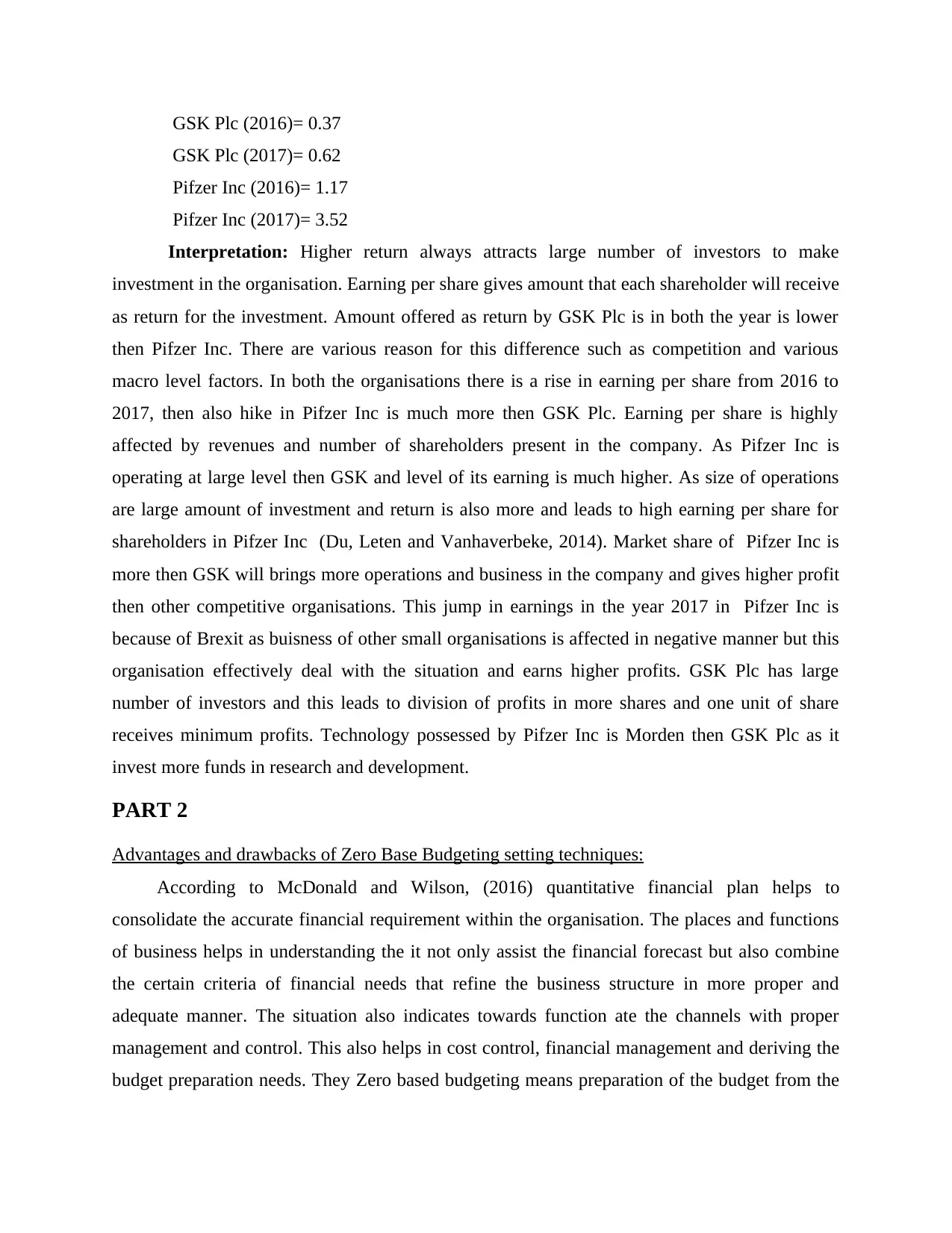
GSK Plc (2016)= 0.37
GSK Plc (2017)= 0.62
Pifzer Inc (2016)= 1.17
Pifzer Inc (2017)= 3.52
Interpretation: Higher return always attracts large number of investors to make
investment in the organisation. Earning per share gives amount that each shareholder will receive
as return for the investment. Amount offered as return by GSK Plc is in both the year is lower
then Pifzer Inc. There are various reason for this difference such as competition and various
macro level factors. In both the organisations there is a rise in earning per share from 2016 to
2017, then also hike in Pifzer Inc is much more then GSK Plc. Earning per share is highly
affected by revenues and number of shareholders present in the company. As Pifzer Inc is
operating at large level then GSK and level of its earning is much higher. As size of operations
are large amount of investment and return is also more and leads to high earning per share for
shareholders in Pifzer Inc (Du, Leten and Vanhaverbeke, 2014). Market share of Pifzer Inc is
more then GSK will brings more operations and business in the company and gives higher profit
then other competitive organisations. This jump in earnings in the year 2017 in Pifzer Inc is
because of Brexit as buisness of other small organisations is affected in negative manner but this
organisation effectively deal with the situation and earns higher profits. GSK Plc has large
number of investors and this leads to division of profits in more shares and one unit of share
receives minimum profits. Technology possessed by Pifzer Inc is Morden then GSK Plc as it
invest more funds in research and development.
PART 2
Advantages and drawbacks of Zero Base Budgeting setting techniques:
According to McDonald and Wilson, (2016) quantitative financial plan helps to
consolidate the accurate financial requirement within the organisation. The places and functions
of business helps in understanding the it not only assist the financial forecast but also combine
the certain criteria of financial needs that refine the business structure in more proper and
adequate manner. The situation also indicates towards function ate the channels with proper
management and control. This also helps in cost control, financial management and deriving the
budget preparation needs. They Zero based budgeting means preparation of the budget from the
GSK Plc (2017)= 0.62
Pifzer Inc (2016)= 1.17
Pifzer Inc (2017)= 3.52
Interpretation: Higher return always attracts large number of investors to make
investment in the organisation. Earning per share gives amount that each shareholder will receive
as return for the investment. Amount offered as return by GSK Plc is in both the year is lower
then Pifzer Inc. There are various reason for this difference such as competition and various
macro level factors. In both the organisations there is a rise in earning per share from 2016 to
2017, then also hike in Pifzer Inc is much more then GSK Plc. Earning per share is highly
affected by revenues and number of shareholders present in the company. As Pifzer Inc is
operating at large level then GSK and level of its earning is much higher. As size of operations
are large amount of investment and return is also more and leads to high earning per share for
shareholders in Pifzer Inc (Du, Leten and Vanhaverbeke, 2014). Market share of Pifzer Inc is
more then GSK will brings more operations and business in the company and gives higher profit
then other competitive organisations. This jump in earnings in the year 2017 in Pifzer Inc is
because of Brexit as buisness of other small organisations is affected in negative manner but this
organisation effectively deal with the situation and earns higher profits. GSK Plc has large
number of investors and this leads to division of profits in more shares and one unit of share
receives minimum profits. Technology possessed by Pifzer Inc is Morden then GSK Plc as it
invest more funds in research and development.
PART 2
Advantages and drawbacks of Zero Base Budgeting setting techniques:
According to McDonald and Wilson, (2016) quantitative financial plan helps to
consolidate the accurate financial requirement within the organisation. The places and functions
of business helps in understanding the it not only assist the financial forecast but also combine
the certain criteria of financial needs that refine the business structure in more proper and
adequate manner. The situation also indicates towards function ate the channels with proper
management and control. This also helps in cost control, financial management and deriving the
budget preparation needs. They Zero based budgeting means preparation of the budget from the
Paraphrase This Document
Need a fresh take? Get an instant paraphrase of this document with our AI Paraphraser
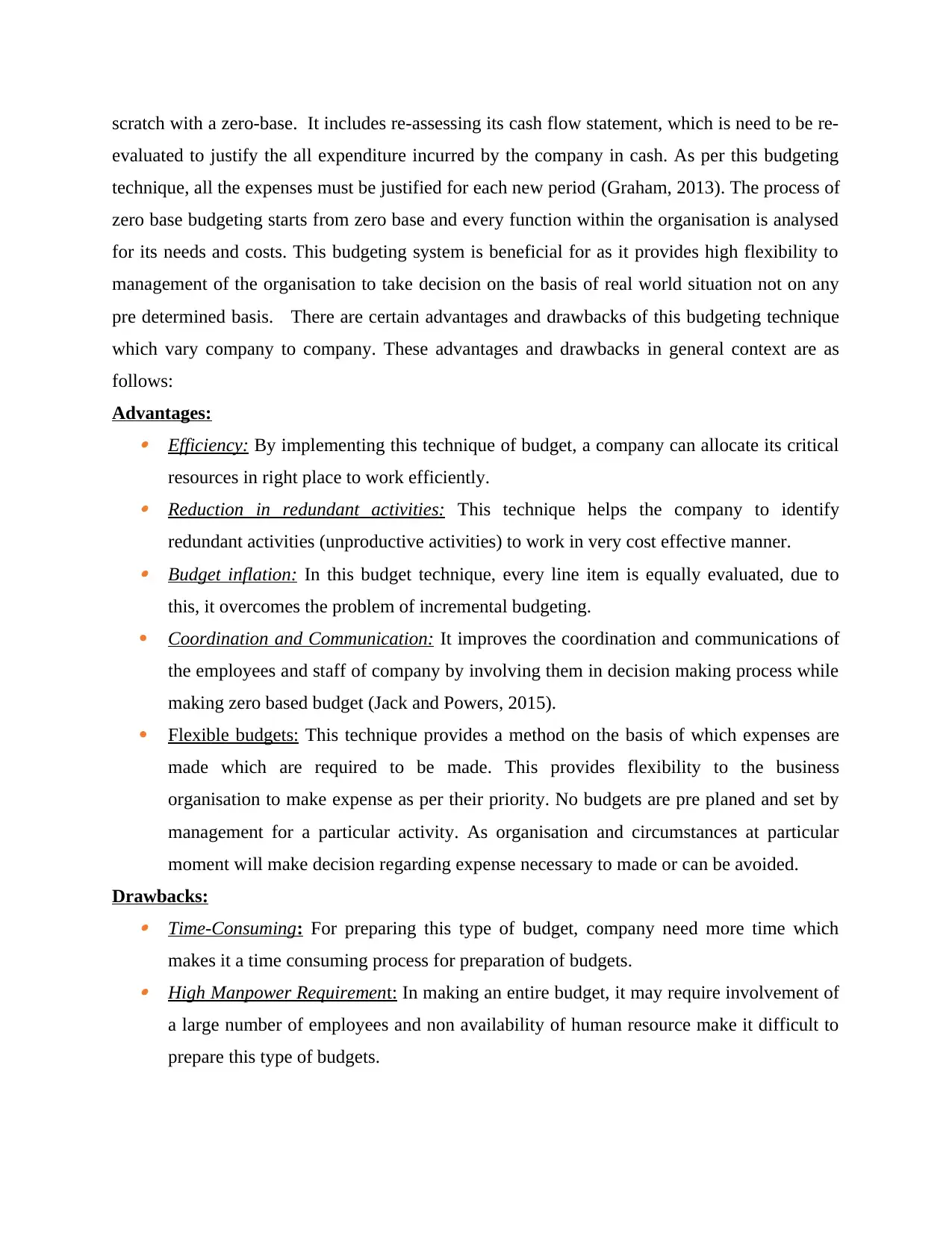
scratch with a zero-base. It includes re-assessing its cash flow statement, which is need to be re-
evaluated to justify the all expenditure incurred by the company in cash. As per this budgeting
technique, all the expenses must be justified for each new period (Graham, 2013). The process of
zero base budgeting starts from zero base and every function within the organisation is analysed
for its needs and costs. This budgeting system is beneficial for as it provides high flexibility to
management of the organisation to take decision on the basis of real world situation not on any
pre determined basis. There are certain advantages and drawbacks of this budgeting technique
which vary company to company. These advantages and drawbacks in general context are as
follows:
Advantages: Efficiency: By implementing this technique of budget, a company can allocate its critical
resources in right place to work efficiently. Reduction in redundant activities: This technique helps the company to identify
redundant activities (unproductive activities) to work in very cost effective manner. Budget inflation: In this budget technique, every line item is equally evaluated, due to
this, it overcomes the problem of incremental budgeting.
Coordination and Communication: It improves the coordination and communications of
the employees and staff of company by involving them in decision making process while
making zero based budget (Jack and Powers, 2015).
Flexible budgets: This technique provides a method on the basis of which expenses are
made which are required to be made. This provides flexibility to the business
organisation to make expense as per their priority. No budgets are pre planed and set by
management for a particular activity. As organisation and circumstances at particular
moment will make decision regarding expense necessary to made or can be avoided.
Drawbacks: Time-Consuming: For preparing this type of budget, company need more time which
makes it a time consuming process for preparation of budgets. High Manpower Requirement: In making an entire budget, it may require involvement of
a large number of employees and non availability of human resource make it difficult to
prepare this type of budgets.
evaluated to justify the all expenditure incurred by the company in cash. As per this budgeting
technique, all the expenses must be justified for each new period (Graham, 2013). The process of
zero base budgeting starts from zero base and every function within the organisation is analysed
for its needs and costs. This budgeting system is beneficial for as it provides high flexibility to
management of the organisation to take decision on the basis of real world situation not on any
pre determined basis. There are certain advantages and drawbacks of this budgeting technique
which vary company to company. These advantages and drawbacks in general context are as
follows:
Advantages: Efficiency: By implementing this technique of budget, a company can allocate its critical
resources in right place to work efficiently. Reduction in redundant activities: This technique helps the company to identify
redundant activities (unproductive activities) to work in very cost effective manner. Budget inflation: In this budget technique, every line item is equally evaluated, due to
this, it overcomes the problem of incremental budgeting.
Coordination and Communication: It improves the coordination and communications of
the employees and staff of company by involving them in decision making process while
making zero based budget (Jack and Powers, 2015).
Flexible budgets: This technique provides a method on the basis of which expenses are
made which are required to be made. This provides flexibility to the business
organisation to make expense as per their priority. No budgets are pre planed and set by
management for a particular activity. As organisation and circumstances at particular
moment will make decision regarding expense necessary to made or can be avoided.
Drawbacks: Time-Consuming: For preparing this type of budget, company need more time which
makes it a time consuming process for preparation of budgets. High Manpower Requirement: In making an entire budget, it may require involvement of
a large number of employees and non availability of human resource make it difficult to
prepare this type of budgets.
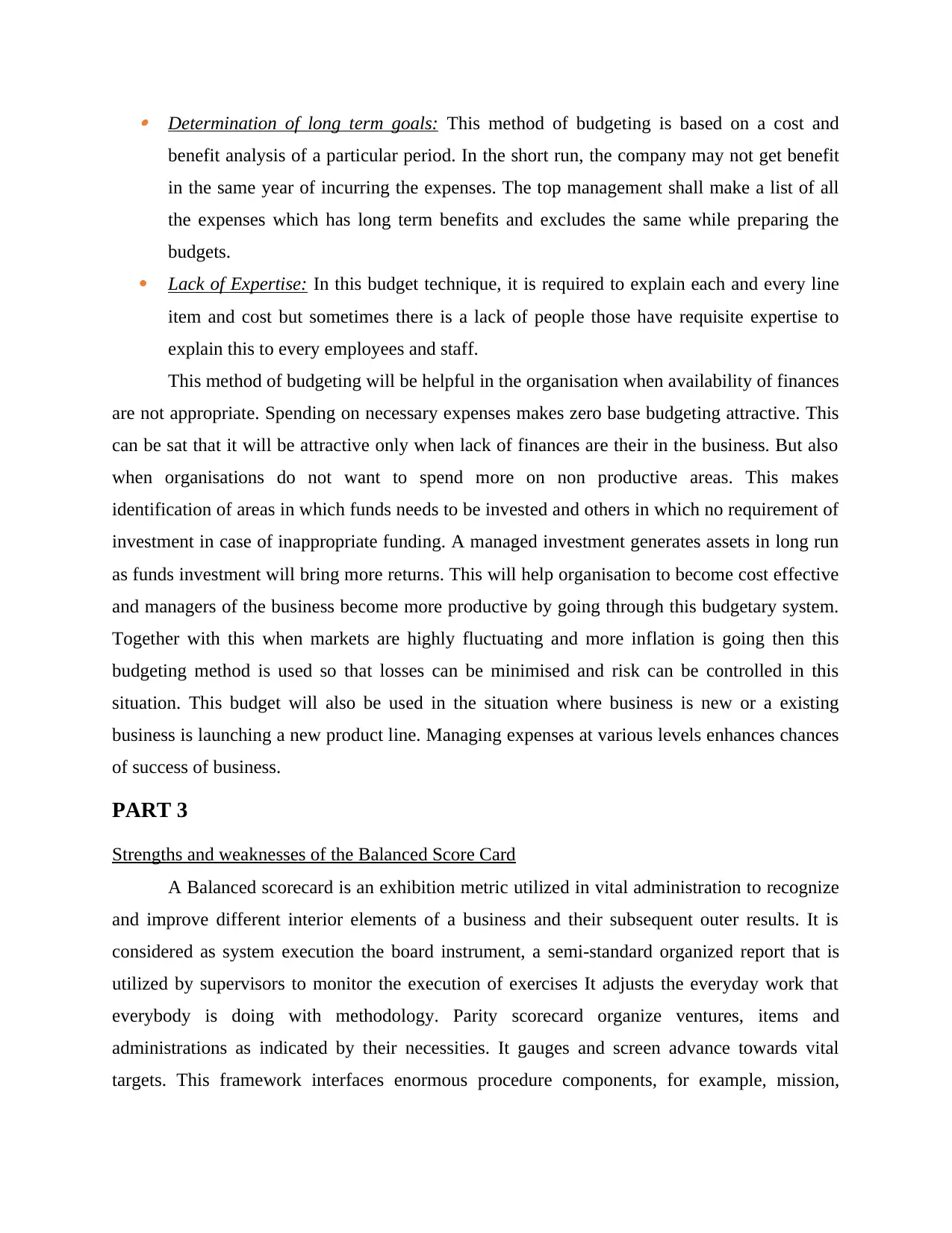
Determination of long term goals: This method of budgeting is based on a cost and
benefit analysis of a particular period. In the short run, the company may not get benefit
in the same year of incurring the expenses. The top management shall make a list of all
the expenses which has long term benefits and excludes the same while preparing the
budgets.
Lack of Expertise: In this budget technique, it is required to explain each and every line
item and cost but sometimes there is a lack of people those have requisite expertise to
explain this to every employees and staff.
This method of budgeting will be helpful in the organisation when availability of finances
are not appropriate. Spending on necessary expenses makes zero base budgeting attractive. This
can be sat that it will be attractive only when lack of finances are their in the business. But also
when organisations do not want to spend more on non productive areas. This makes
identification of areas in which funds needs to be invested and others in which no requirement of
investment in case of inappropriate funding. A managed investment generates assets in long run
as funds investment will bring more returns. This will help organisation to become cost effective
and managers of the business become more productive by going through this budgetary system.
Together with this when markets are highly fluctuating and more inflation is going then this
budgeting method is used so that losses can be minimised and risk can be controlled in this
situation. This budget will also be used in the situation where business is new or a existing
business is launching a new product line. Managing expenses at various levels enhances chances
of success of business.
PART 3
Strengths and weaknesses of the Balanced Score Card
A Balanced scorecard is an exhibition metric utilized in vital administration to recognize
and improve different interior elements of a business and their subsequent outer results. It is
considered as system execution the board instrument, a semi-standard organized report that is
utilized by supervisors to monitor the execution of exercises It adjusts the everyday work that
everybody is doing with methodology. Parity scorecard organize ventures, items and
administrations as indicated by their necessities. It gauges and screen advance towards vital
targets. This framework interfaces enormous procedure components, for example, mission,
benefit analysis of a particular period. In the short run, the company may not get benefit
in the same year of incurring the expenses. The top management shall make a list of all
the expenses which has long term benefits and excludes the same while preparing the
budgets.
Lack of Expertise: In this budget technique, it is required to explain each and every line
item and cost but sometimes there is a lack of people those have requisite expertise to
explain this to every employees and staff.
This method of budgeting will be helpful in the organisation when availability of finances
are not appropriate. Spending on necessary expenses makes zero base budgeting attractive. This
can be sat that it will be attractive only when lack of finances are their in the business. But also
when organisations do not want to spend more on non productive areas. This makes
identification of areas in which funds needs to be invested and others in which no requirement of
investment in case of inappropriate funding. A managed investment generates assets in long run
as funds investment will bring more returns. This will help organisation to become cost effective
and managers of the business become more productive by going through this budgetary system.
Together with this when markets are highly fluctuating and more inflation is going then this
budgeting method is used so that losses can be minimised and risk can be controlled in this
situation. This budget will also be used in the situation where business is new or a existing
business is launching a new product line. Managing expenses at various levels enhances chances
of success of business.
PART 3
Strengths and weaknesses of the Balanced Score Card
A Balanced scorecard is an exhibition metric utilized in vital administration to recognize
and improve different interior elements of a business and their subsequent outer results. It is
considered as system execution the board instrument, a semi-standard organized report that is
utilized by supervisors to monitor the execution of exercises It adjusts the everyday work that
everybody is doing with methodology. Parity scorecard organize ventures, items and
administrations as indicated by their necessities. It gauges and screen advance towards vital
targets. This framework interfaces enormous procedure components, for example, mission,
⊘ This is a preview!⊘
Do you want full access?
Subscribe today to unlock all pages.

Trusted by 1+ million students worldwide
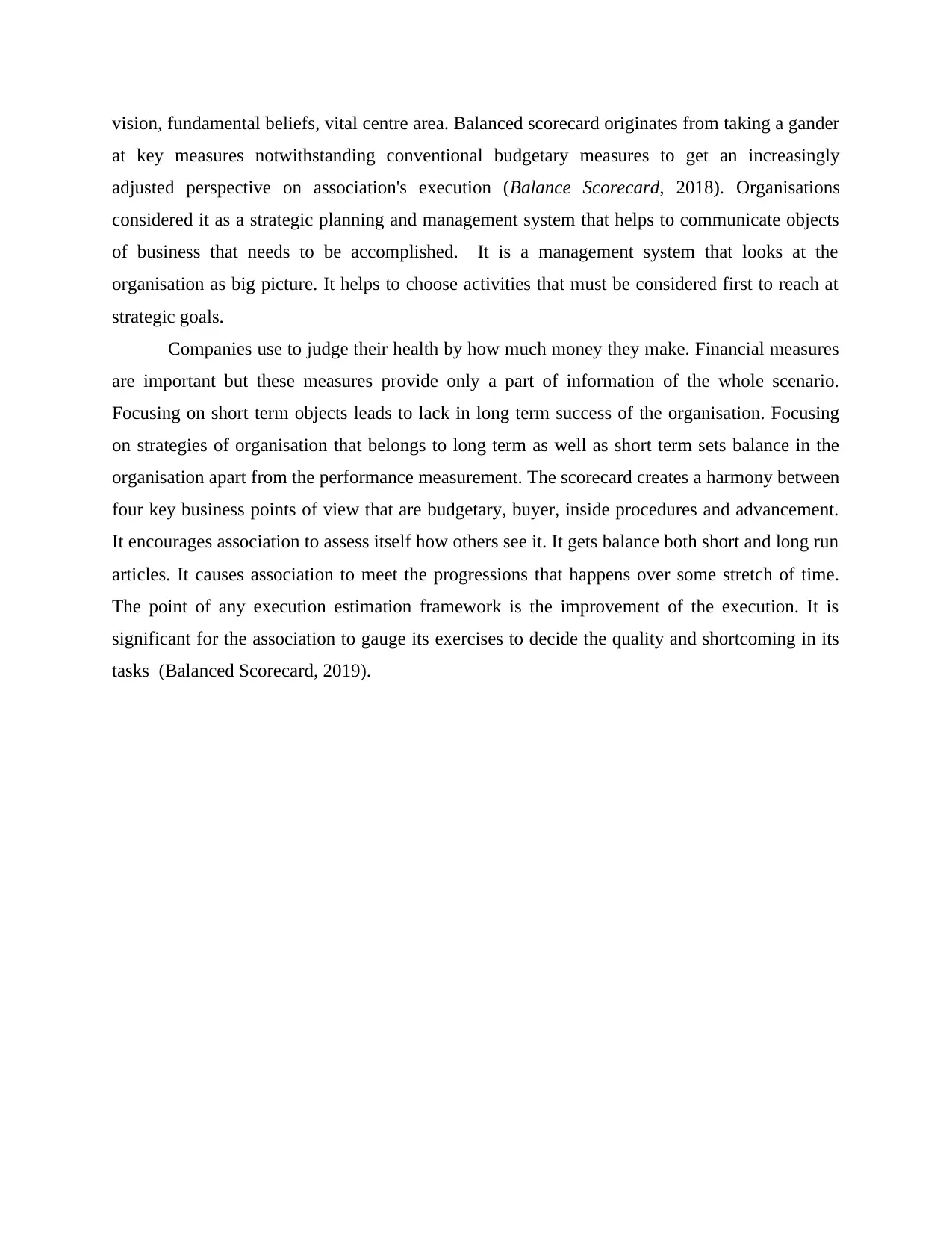
vision, fundamental beliefs, vital centre area. Balanced scorecard originates from taking a gander
at key measures notwithstanding conventional budgetary measures to get an increasingly
adjusted perspective on association's execution (Balance Scorecard, 2018). Organisations
considered it as a strategic planning and management system that helps to communicate objects
of business that needs to be accomplished. It is a management system that looks at the
organisation as big picture. It helps to choose activities that must be considered first to reach at
strategic goals.
Companies use to judge their health by how much money they make. Financial measures
are important but these measures provide only a part of information of the whole scenario.
Focusing on short term objects leads to lack in long term success of the organisation. Focusing
on strategies of organisation that belongs to long term as well as short term sets balance in the
organisation apart from the performance measurement. The scorecard creates a harmony between
four key business points of view that are budgetary, buyer, inside procedures and advancement.
It encourages association to assess itself how others see it. It gets balance both short and long run
articles. It causes association to meet the progressions that happens over some stretch of time.
The point of any execution estimation framework is the improvement of the execution. It is
significant for the association to gauge its exercises to decide the quality and shortcoming in its
tasks (Balanced Scorecard, 2019).
at key measures notwithstanding conventional budgetary measures to get an increasingly
adjusted perspective on association's execution (Balance Scorecard, 2018). Organisations
considered it as a strategic planning and management system that helps to communicate objects
of business that needs to be accomplished. It is a management system that looks at the
organisation as big picture. It helps to choose activities that must be considered first to reach at
strategic goals.
Companies use to judge their health by how much money they make. Financial measures
are important but these measures provide only a part of information of the whole scenario.
Focusing on short term objects leads to lack in long term success of the organisation. Focusing
on strategies of organisation that belongs to long term as well as short term sets balance in the
organisation apart from the performance measurement. The scorecard creates a harmony between
four key business points of view that are budgetary, buyer, inside procedures and advancement.
It encourages association to assess itself how others see it. It gets balance both short and long run
articles. It causes association to meet the progressions that happens over some stretch of time.
The point of any execution estimation framework is the improvement of the execution. It is
significant for the association to gauge its exercises to decide the quality and shortcoming in its
tasks (Balanced Scorecard, 2019).
Paraphrase This Document
Need a fresh take? Get an instant paraphrase of this document with our AI Paraphraser
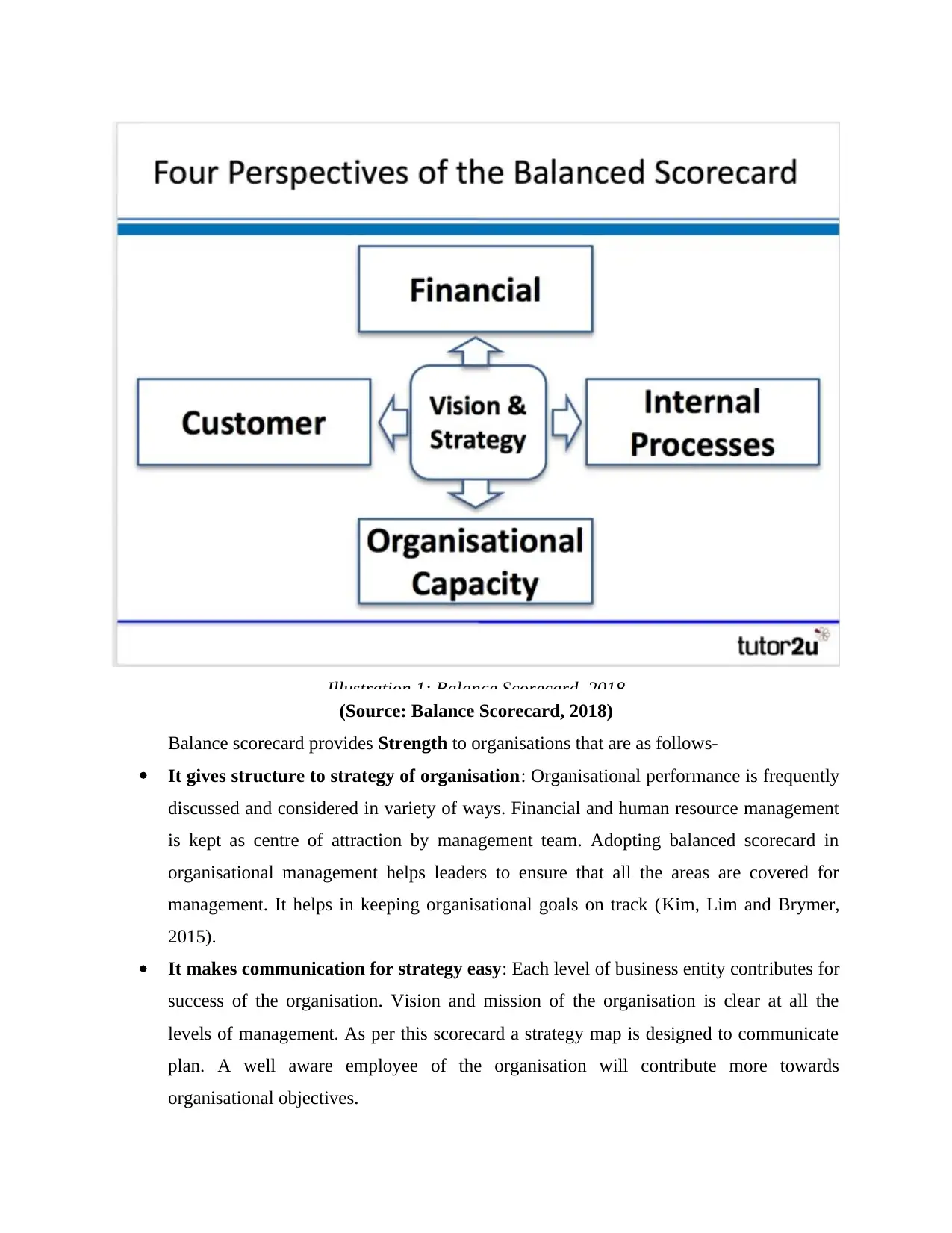
(Source: Balance Scorecard, 2018)
Balance scorecard provides Strength to organisations that are as follows-
It gives structure to strategy of organisation: Organisational performance is frequently
discussed and considered in variety of ways. Financial and human resource management
is kept as centre of attraction by management team. Adopting balanced scorecard in
organisational management helps leaders to ensure that all the areas are covered for
management. It helps in keeping organisational goals on track (Kim, Lim and Brymer,
2015).
It makes communication for strategy easy: Each level of business entity contributes for
success of the organisation. Vision and mission of the organisation is clear at all the
levels of management. As per this scorecard a strategy map is designed to communicate
plan. A well aware employee of the organisation will contribute more towards
organisational objectives.
Illustration 1: Balance Scorecard, 2018
Balance scorecard provides Strength to organisations that are as follows-
It gives structure to strategy of organisation: Organisational performance is frequently
discussed and considered in variety of ways. Financial and human resource management
is kept as centre of attraction by management team. Adopting balanced scorecard in
organisational management helps leaders to ensure that all the areas are covered for
management. It helps in keeping organisational goals on track (Kim, Lim and Brymer,
2015).
It makes communication for strategy easy: Each level of business entity contributes for
success of the organisation. Vision and mission of the organisation is clear at all the
levels of management. As per this scorecard a strategy map is designed to communicate
plan. A well aware employee of the organisation will contribute more towards
organisational objectives.
Illustration 1: Balance Scorecard, 2018
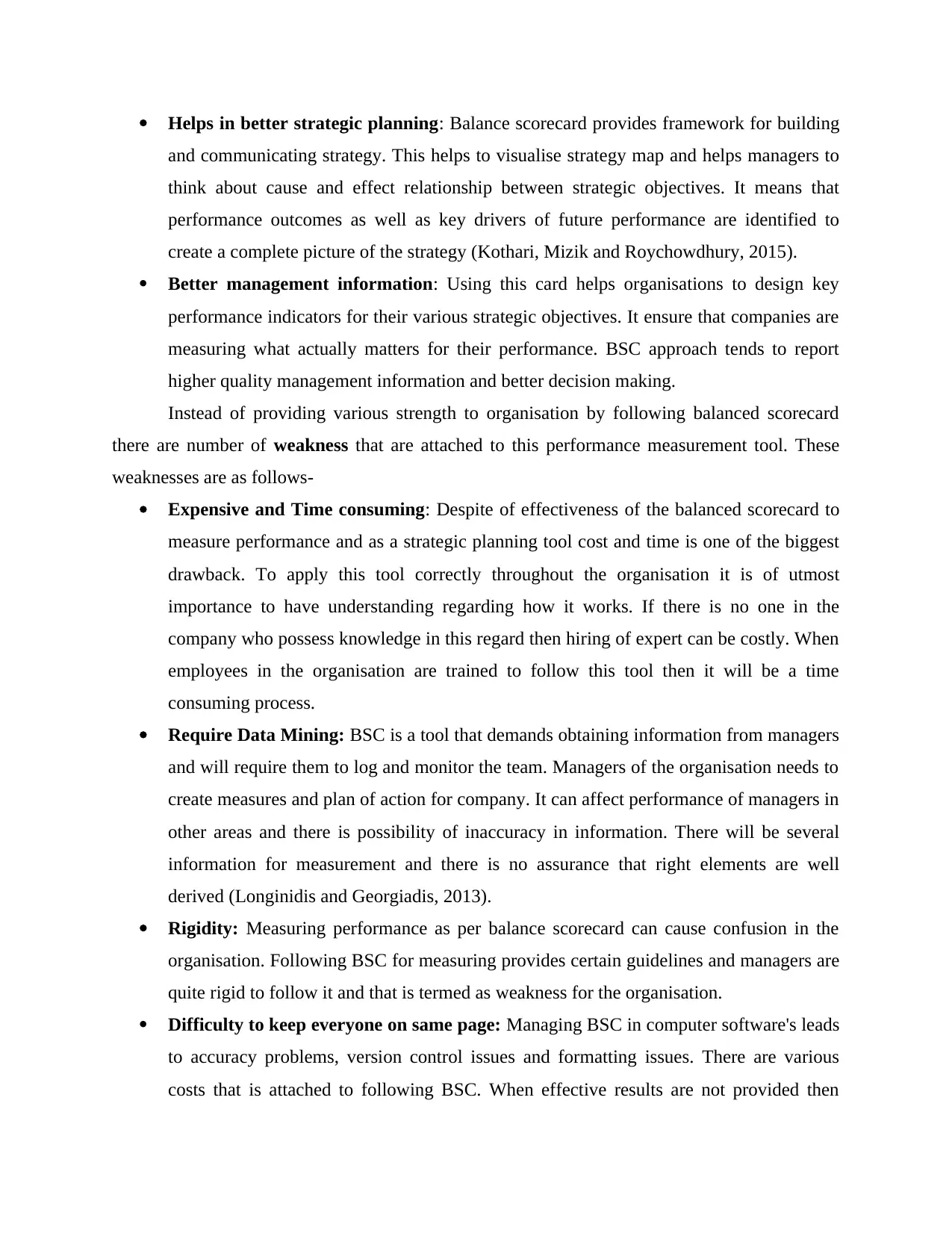
Helps in better strategic planning: Balance scorecard provides framework for building
and communicating strategy. This helps to visualise strategy map and helps managers to
think about cause and effect relationship between strategic objectives. It means that
performance outcomes as well as key drivers of future performance are identified to
create a complete picture of the strategy (Kothari, Mizik and Roychowdhury, 2015).
Better management information: Using this card helps organisations to design key
performance indicators for their various strategic objectives. It ensure that companies are
measuring what actually matters for their performance. BSC approach tends to report
higher quality management information and better decision making.
Instead of providing various strength to organisation by following balanced scorecard
there are number of weakness that are attached to this performance measurement tool. These
weaknesses are as follows-
Expensive and Time consuming: Despite of effectiveness of the balanced scorecard to
measure performance and as a strategic planning tool cost and time is one of the biggest
drawback. To apply this tool correctly throughout the organisation it is of utmost
importance to have understanding regarding how it works. If there is no one in the
company who possess knowledge in this regard then hiring of expert can be costly. When
employees in the organisation are trained to follow this tool then it will be a time
consuming process.
Require Data Mining: BSC is a tool that demands obtaining information from managers
and will require them to log and monitor the team. Managers of the organisation needs to
create measures and plan of action for company. It can affect performance of managers in
other areas and there is possibility of inaccuracy in information. There will be several
information for measurement and there is no assurance that right elements are well
derived (Longinidis and Georgiadis, 2013).
Rigidity: Measuring performance as per balance scorecard can cause confusion in the
organisation. Following BSC for measuring provides certain guidelines and managers are
quite rigid to follow it and that is termed as weakness for the organisation.
Difficulty to keep everyone on same page: Managing BSC in computer software's leads
to accuracy problems, version control issues and formatting issues. There are various
costs that is attached to following BSC. When effective results are not provided then
and communicating strategy. This helps to visualise strategy map and helps managers to
think about cause and effect relationship between strategic objectives. It means that
performance outcomes as well as key drivers of future performance are identified to
create a complete picture of the strategy (Kothari, Mizik and Roychowdhury, 2015).
Better management information: Using this card helps organisations to design key
performance indicators for their various strategic objectives. It ensure that companies are
measuring what actually matters for their performance. BSC approach tends to report
higher quality management information and better decision making.
Instead of providing various strength to organisation by following balanced scorecard
there are number of weakness that are attached to this performance measurement tool. These
weaknesses are as follows-
Expensive and Time consuming: Despite of effectiveness of the balanced scorecard to
measure performance and as a strategic planning tool cost and time is one of the biggest
drawback. To apply this tool correctly throughout the organisation it is of utmost
importance to have understanding regarding how it works. If there is no one in the
company who possess knowledge in this regard then hiring of expert can be costly. When
employees in the organisation are trained to follow this tool then it will be a time
consuming process.
Require Data Mining: BSC is a tool that demands obtaining information from managers
and will require them to log and monitor the team. Managers of the organisation needs to
create measures and plan of action for company. It can affect performance of managers in
other areas and there is possibility of inaccuracy in information. There will be several
information for measurement and there is no assurance that right elements are well
derived (Longinidis and Georgiadis, 2013).
Rigidity: Measuring performance as per balance scorecard can cause confusion in the
organisation. Following BSC for measuring provides certain guidelines and managers are
quite rigid to follow it and that is termed as weakness for the organisation.
Difficulty to keep everyone on same page: Managing BSC in computer software's leads
to accuracy problems, version control issues and formatting issues. There are various
costs that is attached to following BSC. When effective results are not provided then
⊘ This is a preview!⊘
Do you want full access?
Subscribe today to unlock all pages.

Trusted by 1+ million students worldwide
1 out of 18
Related Documents
Your All-in-One AI-Powered Toolkit for Academic Success.
+13062052269
info@desklib.com
Available 24*7 on WhatsApp / Email
![[object Object]](/_next/static/media/star-bottom.7253800d.svg)
Unlock your academic potential
Copyright © 2020–2025 A2Z Services. All Rights Reserved. Developed and managed by ZUCOL.





